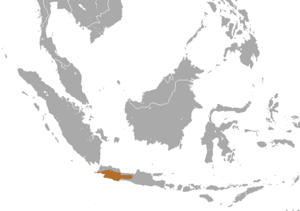Silvery gibbon facts for kids
Quick facts for kids Silvery gibbon |
|
|---|---|
 |
|
| A silvery gibbon foraging in a Ficus tree. Photograph taken in Mount Halimun Salak National Park | |
| Conservation status | |
| Scientific classification | |
| Genus: |
Hylobates
|
| Species: |
moloch
|
 |
|
| Silvery gibbon range | |
The silvery gibbon (Hylobates moloch), also called the Javan gibbon, is a type of primate. It belongs to the gibbon family. These amazing animals live only on the Indonesian island of Java. They make their homes in untouched rainforests, even high up in the mountains.
Silvery gibbons can be found at altitudes up to about 2,450 meters (8,000 feet). Sadly, they have been listed as Endangered since 2008. This means their numbers are very low. Experts believe there are fewer than 2,500 adult silvery gibbons left in the wild.
Contents
What Silvery Gibbons Look Like
Silvery gibbons have beautiful bluish-grey fur. They also have a dark grey or black cap on their heads. Like all gibbons, they do not have an outside tail.
These gibbons have long, curved fingers. Their front arms are much longer than their back legs. An adult silvery gibbon usually weighs about 8 kilograms (17.6 pounds).
How Silvery Gibbons Live
Silvery gibbons are active during the day, which means they are diurnal. They spend almost all their time in trees, making them arboreal animals. They are very skilled at climbing.
They move through the forest by swinging from branch to branch. This special way of moving is called brachiation. They can do this because their wrist joints are very flexible. They can also fully rotate their upper arms and lock their elbows when hanging.
What Silvery Gibbons Eat
The diet of a silvery gibbon mainly includes fruits. They also enjoy eating leaves and flowers.
Silvery Gibbon Life Cycle
Female silvery gibbons usually give birth to one baby at a time. This happens about every three years. The pregnancy, or gestation, lasts for seven months.
The baby gibbon drinks its mother's milk for about 18 months. Young gibbons stay with their family group. They live with their family until they are fully grown, which is around eight to ten years old.
Threats and Conservation Efforts
The silvery gibbon is one of the most endangered primates on Earth. It is listed as Endangered on the IUCN Red List. This means they are at high risk of disappearing forever.
Why Silvery Gibbons Are in Danger
One big reason silvery gibbons are in danger is habitat destruction. Java is a very crowded island. People are cutting down forests where gibbons live. This leaves them with less and less natural space.
Another serious threat is the illegal pet trade. Hunters sometimes catch adult gibbons to take their babies. These young gibbons are then sold as pets in markets. This practice is very harmful to the wild population.
Protecting Silvery Gibbons
There are fewer than 2,000 silvery gibbons left in the wild. They live in about eight main areas. These areas are important for the species to survive and have healthy babies. There are also many smaller groups, but they are not large enough to thrive on their own.
Mount Halimun Salak National Park is home to the largest group, with about 1,000 gibbons. Other large groups live in Gunung Ciremai National Park and Gunung Gede Pangrango National Park. In the latter park, there is a special Javan Gibbon Centre. This center helps gibbons that were once pets learn how to live in the wild again.
Many zoos around the world are also working to save silvery gibbons. They have special breeding programs. Even with all these efforts, the future of the silvery gibbon is still uncertain.
Silvery Gibbon Behavior
Like all gibbon species, silvery gibbons live in pairs. They also claim and protect their own territory. Their territories are usually about 42 acres in size.
Communication and Territory Defense
Female gibbons sing loudly several times a day to show where their territory is. If they see other gibbons that don't belong, the male gibbon will scream. This is his way of trying to scare them away.
Most of the solo songs or screams are made by females. Female songs usually start after 5:00 AM, with the most singing happening around 6:00 AM. Male songs often begin earlier, sometimes in the dark, between 3:55 AM and 4:40 AM.
Males also join together to sing in a "chorus" with at least three gibbons. These choruses happen about every 8.5 days. They start earlier and last longer than the female solo songs. Male gibbons can be very protective of their territory.
Types of Silvery Gibbons
Some scientists believe there are two different types, or subspecies, of Hylobates moloch:
- Western silvery gibbon or western Javan gibbon, H. m. moloch
- Eastern silvery gibbon or central Javan gibbon, H. m. pongoalsoni
Images for kids





